South African Literature
What are some of the other great works by South Africans? South African Professor of English Colin Gardner has some ideas for what to read once you've finished Cry, the Beloved Country!
More South African reads for your bookshelf!More in Books
- What legacy did Paton leave for other South African writers? Find out more.
- What did books symbolize in Cry, the Beloved Country
- What are some of your favorite people reading? Browse the bookshelves of celebrities, politicians, writers and more.
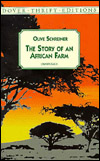
The Story of an African Farm
By Olive Schreiner
This novel, published in 1883 in London, made a considerable stir. Olive Schreiner, while in her twenties, was the first colonial writer to be acclaimed in British literary circles. More than one hundred years later, the book has lost none of its haunting, probing, heart-gripping power. Its central character, Lyndall, is a woman of great passion and intellectual intensity. In the course of an intriguing narrative, she expresses eloquently to her friends, but particularly to the meditative Waldo who shares many of her concerns, her thoughts about love, death, religion, injustice, human relationships in South Africa, and the position of women in society. (Schreiner was a strong early feminist.) Lyndall is independent and unconventional, and her story is surprising but eventually deeply sad. The novel is not without flaws, but it is richly varied: besides its challenging discussions, it contains lively characters and dialogue, vivid descriptions of South African activities and landscapes, and a good deal of humor and satire.
Return to South Africa's bookshelf.
By Olive Schreiner
This novel, published in 1883 in London, made a considerable stir. Olive Schreiner, while in her twenties, was the first colonial writer to be acclaimed in British literary circles. More than one hundred years later, the book has lost none of its haunting, probing, heart-gripping power. Its central character, Lyndall, is a woman of great passion and intellectual intensity. In the course of an intriguing narrative, she expresses eloquently to her friends, but particularly to the meditative Waldo who shares many of her concerns, her thoughts about love, death, religion, injustice, human relationships in South Africa, and the position of women in society. (Schreiner was a strong early feminist.) Lyndall is independent and unconventional, and her story is surprising but eventually deeply sad. The novel is not without flaws, but it is richly varied: besides its challenging discussions, it contains lively characters and dialogue, vivid descriptions of South African activities and landscapes, and a good deal of humor and satire.
Return to South Africa's bookshelf.
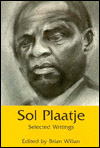
Mhudi
By Sol T. Plaatje
Mhudi (pronounced Moody), published in 1930 but written ten years earlier, is the first novel published by an African South African. Its importance and its quiet power have only been generally recognized in the last thirty years. Plaatje was a journalist, diarist, linguist, translator of Shakespeare, and political activist who had traveled to Britain, the US and Canada to plead the cause of black South Africans. His harrowing Native Life in South Africa, published in London in 1916, is in some respects a forerunner of Cry, the Beloved Country.
But Mhudi makes the case for tolerance, multicultural empathy, and the recognition of human dignity and feeling in a subtle way through an epic historical tale, set in the north of the country in the 1830s. One African group—the Barolong, is attacked by another, the Ndebele—under the warlike Mzilikazi. The peace-loving Barolong, are assisted by the white Boers, some of whom, however, also have their own agenda. The central figures are the attractive and spirited Mhudi and her husband Ra-Thaga, but we are invited to experience from within a wide range of characters from various backgrounds. Plaatje is even interested in the reactions of animals.
In its dramatic ebb and flow, which combines African and Western narrative traditions, the novel confronts us with issues of innocence and experience, war and peace, courage and tenderness, revenge and jealousy, actions and their repercussions, prejudice and open-mindedness, and cultural misunderstandings and potential harmonies.
Return to South Africa's bookshelf.
By Sol T. Plaatje
Mhudi (pronounced Moody), published in 1930 but written ten years earlier, is the first novel published by an African South African. Its importance and its quiet power have only been generally recognized in the last thirty years. Plaatje was a journalist, diarist, linguist, translator of Shakespeare, and political activist who had traveled to Britain, the US and Canada to plead the cause of black South Africans. His harrowing Native Life in South Africa, published in London in 1916, is in some respects a forerunner of Cry, the Beloved Country.
But Mhudi makes the case for tolerance, multicultural empathy, and the recognition of human dignity and feeling in a subtle way through an epic historical tale, set in the north of the country in the 1830s. One African group—the Barolong, is attacked by another, the Ndebele—under the warlike Mzilikazi. The peace-loving Barolong, are assisted by the white Boers, some of whom, however, also have their own agenda. The central figures are the attractive and spirited Mhudi and her husband Ra-Thaga, but we are invited to experience from within a wide range of characters from various backgrounds. Plaatje is even interested in the reactions of animals.
In its dramatic ebb and flow, which combines African and Western narrative traditions, the novel confronts us with issues of innocence and experience, war and peace, courage and tenderness, revenge and jealousy, actions and their repercussions, prejudice and open-mindedness, and cultural misunderstandings and potential harmonies.
Return to South Africa's bookshelf.
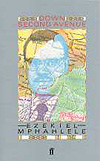
Down Second Avenue
By Es'kia Mphahlele
Mphahlele, novelist, autobiographer, literary and social critic, poet—now in his eighties—is the grand old man of South African letters. Down Second Avenue, first published in 1957, tells the story of Mphahlele's life until his departure into exile in 1955. (He returned to South Africa in 1977.) The book is striking for its content: having been a herd boy in the country, Mphahlele moved to impoverished black townships in the Johannesburg area. The hardships of the poor and the despised, the complexities of the author's personal and family life, and his achievement of a good education and a job as a journalist, are all described in lively but careful detail. What animates the book and makes it profoundly memorable is the powerful but tightly controlled emotion, which underpins its seemingly straightforward narrative style.
Return to South Africa's bookshelf.
By Es'kia Mphahlele
Mphahlele, novelist, autobiographer, literary and social critic, poet—now in his eighties—is the grand old man of South African letters. Down Second Avenue, first published in 1957, tells the story of Mphahlele's life until his departure into exile in 1955. (He returned to South Africa in 1977.) The book is striking for its content: having been a herd boy in the country, Mphahlele moved to impoverished black townships in the Johannesburg area. The hardships of the poor and the despised, the complexities of the author's personal and family life, and his achievement of a good education and a job as a journalist, are all described in lively but careful detail. What animates the book and makes it profoundly memorable is the powerful but tightly controlled emotion, which underpins its seemingly straightforward narrative style.
Return to South Africa's bookshelf.

Boesman and Lena
By Athol Fugard
Athol Fugard has an international reputation. This play is in some respects reminiscent of Samuel Beckett's Waiting for Godot. In a dramatic dialogue which is bleak but emotionally varied and shot through with wild humor, the two protagonists, a man and a woman, struggle with each other and with a strong sense of the meaninglessness of their lives. But whereas Beckett's characters' near-despair was philosophical, existential, Boesman and Lena, two so-called "Coloreds", are the victims of an uncaring social system. Having no legal right to a place of residence, they are constantly on the move through the mudflats of the Eastern Cape, carrying their meager belongings and scraps of metal and wood from place to place. Scorned by the powers-that-be, they have ended up despising themselves and each other. And yet at the same time the will to survive and to find some meaning is strong in them.
Return to South Africa's bookshelf.
By Athol Fugard
Athol Fugard has an international reputation. This play is in some respects reminiscent of Samuel Beckett's Waiting for Godot. In a dramatic dialogue which is bleak but emotionally varied and shot through with wild humor, the two protagonists, a man and a woman, struggle with each other and with a strong sense of the meaninglessness of their lives. But whereas Beckett's characters' near-despair was philosophical, existential, Boesman and Lena, two so-called "Coloreds", are the victims of an uncaring social system. Having no legal right to a place of residence, they are constantly on the move through the mudflats of the Eastern Cape, carrying their meager belongings and scraps of metal and wood from place to place. Scorned by the powers-that-be, they have ended up despising themselves and each other. And yet at the same time the will to survive and to find some meaning is strong in them.
Return to South Africa's bookshelf.
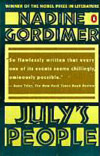
July's People
By Nadine Gordimer
Nadine Gordimer won the Nobel Prize for Literature in 1991. This novel, published in 1981, dramatizes the time of fearsome revolutionary transition that is hinted at in Paton's novel and that haunted South African consciousness for decades. What we see, however, are not the violence and the fighting that are spoken of, but the effects on the white bourgeois Smales family of their fleeing the city and being harbored in the distant small village of July, their African domestic servant. With the disappearance of the socio-economic structure that had maintained not only the master-servant relationship but their very identities, Maureen Smales, the central character, experiences the disintegration of what she had thought was a reasonable and humane bond with July (whose real name, she discovers, is Mwawate). At the same time her roles as wife and mother seem to evaporate. The protagonists find among other things that they have no common vocabulary with which to handle the new situation that they are in. The significance of the novel is not confined to a particular era or a particular place.
Return to South Africa's bookshelf.
By Nadine Gordimer
Nadine Gordimer won the Nobel Prize for Literature in 1991. This novel, published in 1981, dramatizes the time of fearsome revolutionary transition that is hinted at in Paton's novel and that haunted South African consciousness for decades. What we see, however, are not the violence and the fighting that are spoken of, but the effects on the white bourgeois Smales family of their fleeing the city and being harbored in the distant small village of July, their African domestic servant. With the disappearance of the socio-economic structure that had maintained not only the master-servant relationship but their very identities, Maureen Smales, the central character, experiences the disintegration of what she had thought was a reasonable and humane bond with July (whose real name, she discovers, is Mwawate). At the same time her roles as wife and mother seem to evaporate. The protagonists find among other things that they have no common vocabulary with which to handle the new situation that they are in. The significance of the novel is not confined to a particular era or a particular place.
Return to South Africa's bookshelf.
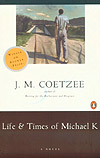
Life and Times of Michael K
By J.M. Coetzee
Coetzee is the latest winner of the Nobel Prize for Literature, and his reputation as a writer was solidified by this work, which also won him the Booker Prize. First published in 1983, Life and Times of Michael K, rather like July's People, pictures a time of civil war and socio-political upheaval. But Michael K is a survivor. Lowly, without power or ambition, he is a strange, self-possessed, detached person who retains his composure and navigates his way (he makes long journeys on foot, and is twice imprisoned) through the chaos of a society collapsing around him. In the face of the battle for power, he offers the value of gardening, of nurturing life from the earth. The narrative is crisp and riveting, but it is not to be read simply in everyday representational terms. The novel pictures not only one person's way of negotiating the danger and the trauma of a revolutionary situation but, more obliquely, the way in which a writer can achieve a certain freedom and independence in the face of the fierce pressures exerted by history and society.
Return to South Africa's bookshelf.
By J.M. Coetzee
Coetzee is the latest winner of the Nobel Prize for Literature, and his reputation as a writer was solidified by this work, which also won him the Booker Prize. First published in 1983, Life and Times of Michael K, rather like July's People, pictures a time of civil war and socio-political upheaval. But Michael K is a survivor. Lowly, without power or ambition, he is a strange, self-possessed, detached person who retains his composure and navigates his way (he makes long journeys on foot, and is twice imprisoned) through the chaos of a society collapsing around him. In the face of the battle for power, he offers the value of gardening, of nurturing life from the earth. The narrative is crisp and riveting, but it is not to be read simply in everyday representational terms. The novel pictures not only one person's way of negotiating the danger and the trauma of a revolutionary situation but, more obliquely, the way in which a writer can achieve a certain freedom and independence in the face of the fierce pressures exerted by history and society.
Return to South Africa's bookshelf.
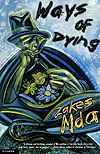
Ways of Dying
By Zakes Mda
This recent novel is firmly rooted in African village life and the life of African townships and informal settlements during the tempestuous transition period of the early 1990s. It is a postmodern work with many mini-narratives woven together to form a complex whole. The central thread concerns the lives and adventures of Toloki, who becomes a professional mourner at funerals, and the always slightly mysterious Noria. The novel encompasses a wide range of moods: it is at times horrifying, seriously analytical, romantic, funny, fantastic, satirical. There are also moments of magical realism, in which everyday normality seems to be transcended. A recurring theme is that of art: Toloki can draw magically with crayons and can with magazine covers turn a shack into a stately dwelling; his blacksmith father has made metal figurines; and Noria's voice has inspired them both.
Return to South Africa's bookshelf.
By Zakes Mda
This recent novel is firmly rooted in African village life and the life of African townships and informal settlements during the tempestuous transition period of the early 1990s. It is a postmodern work with many mini-narratives woven together to form a complex whole. The central thread concerns the lives and adventures of Toloki, who becomes a professional mourner at funerals, and the always slightly mysterious Noria. The novel encompasses a wide range of moods: it is at times horrifying, seriously analytical, romantic, funny, fantastic, satirical. There are also moments of magical realism, in which everyday normality seems to be transcended. A recurring theme is that of art: Toloki can draw magically with crayons and can with magazine covers turn a shack into a stately dwelling; his blacksmith father has made metal figurines; and Noria's voice has inspired them both.
Return to South Africa's bookshelf.
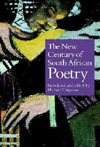
The New Century of South African Poetry
Introduced and edited by Michael Chapman
South Africa, with its dramatic history, has produced an excitingly rich and varied store of poetry. This anthology provides a comprehensive glimpse of this poetry, in a number of the country's languages (though here all translated into English).
One of the major themes has been the ugliness of the apartheid system. Mongane Serote for example, in "City Johannesburg," a poem that is both a protest and a plea, describes the bitter experience of working in the city and then returning to his segregated impoverished township. Sipho Sepamla constructs in "To Whom It May Concern" a sardonic testimonial highlighting the way the laws and bureaucracy undermine the humanity of black people. Mafika Gwala, in "Kwela-ride," paints a vivid grim picture of an African, who has forgotten his pass, being taken away in a police van.
Apartheid sent many people to prison. In "Letter to Martha, 4" Dennis Brutus offers a poignant and forceful sketch of an aspect of prison life. In Oswald Mbuyiseni Mtshali's "Boy on a Swing" one of the boy's childlike questions is: "Why was my father jailed?"
But South African poetry isn't all about oppression. Ruth Miller, in "Penguin on the Beach," offers a lovely evocation of a penguin that seems afraid to enter the sea. Mazisi Kunene, in "Vision of Peace," presents striking images of nature and of childhood, while Douglas Livingstone's "Steel Giraffes" uses images of the dockyard where he says goodbye to a woman to crystallize his overwhelming grief. "Testimony" by Chris Mann is a memorable love poem.
Return to South Africa's bookshelf.
Introduced and edited by Michael Chapman
South Africa, with its dramatic history, has produced an excitingly rich and varied store of poetry. This anthology provides a comprehensive glimpse of this poetry, in a number of the country's languages (though here all translated into English).
One of the major themes has been the ugliness of the apartheid system. Mongane Serote for example, in "City Johannesburg," a poem that is both a protest and a plea, describes the bitter experience of working in the city and then returning to his segregated impoverished township. Sipho Sepamla constructs in "To Whom It May Concern" a sardonic testimonial highlighting the way the laws and bureaucracy undermine the humanity of black people. Mafika Gwala, in "Kwela-ride," paints a vivid grim picture of an African, who has forgotten his pass, being taken away in a police van.
Apartheid sent many people to prison. In "Letter to Martha, 4" Dennis Brutus offers a poignant and forceful sketch of an aspect of prison life. In Oswald Mbuyiseni Mtshali's "Boy on a Swing" one of the boy's childlike questions is: "Why was my father jailed?"
But South African poetry isn't all about oppression. Ruth Miller, in "Penguin on the Beach," offers a lovely evocation of a penguin that seems afraid to enter the sea. Mazisi Kunene, in "Vision of Peace," presents striking images of nature and of childhood, while Douglas Livingstone's "Steel Giraffes" uses images of the dockyard where he says goodbye to a woman to crystallize his overwhelming grief. "Testimony" by Chris Mann is a memorable love poem.
Return to South Africa's bookshelf.
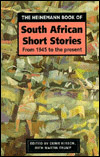
A Century of South African Short Stories
Edited by Martin Trump and Jean Marquard
South Africa has a strong tradition of short story writing. This anthology offers a considerable range of the kinds of stories written in the last century.
A number of the stories relate directly or indirectly to apartheid experiences. James Matthews's "The Park" focuses on the feelings of a Colored boy who is not allowed to play on the swings and slides in a "whites only" park. "The Toilet" by Gcina Mhlope shows how a young African woman, hemmed in by restrictions, is able to use a small, disused public toilet as a refuge in which she can gain her composure and develop her creativity. Ahmed Essop's "The Hajji" is about the tragic anger of a Muslim against his brother who has disowned him and managed to escape on to the other side of the great apartheid divide.
But there are other themes in South African life and fiction. Pauline Smith's story, "Desolation", written in the 1920s, is of an aged destitute "poor white" woman who makes a terrible journey in an attempt to provide for her orphaned grandson. Bessie Head's "Life"—pronounced "Leefay"—describes a marriage of two spirited independent people which ends in a murder. "Journal of a Wall" by Ivan Vladislavic is a psychodrama in which a man observes his neighbors obsessively.
Return to South Africa's bookshelf.
Edited by Martin Trump and Jean Marquard
South Africa has a strong tradition of short story writing. This anthology offers a considerable range of the kinds of stories written in the last century.
A number of the stories relate directly or indirectly to apartheid experiences. James Matthews's "The Park" focuses on the feelings of a Colored boy who is not allowed to play on the swings and slides in a "whites only" park. "The Toilet" by Gcina Mhlope shows how a young African woman, hemmed in by restrictions, is able to use a small, disused public toilet as a refuge in which she can gain her composure and develop her creativity. Ahmed Essop's "The Hajji" is about the tragic anger of a Muslim against his brother who has disowned him and managed to escape on to the other side of the great apartheid divide.
But there are other themes in South African life and fiction. Pauline Smith's story, "Desolation", written in the 1920s, is of an aged destitute "poor white" woman who makes a terrible journey in an attempt to provide for her orphaned grandson. Bessie Head's "Life"—pronounced "Leefay"—describes a marriage of two spirited independent people which ends in a murder. "Journal of a Wall" by Ivan Vladislavic is a psychodrama in which a man observes his neighbors obsessively.
Return to South Africa's bookshelf.



